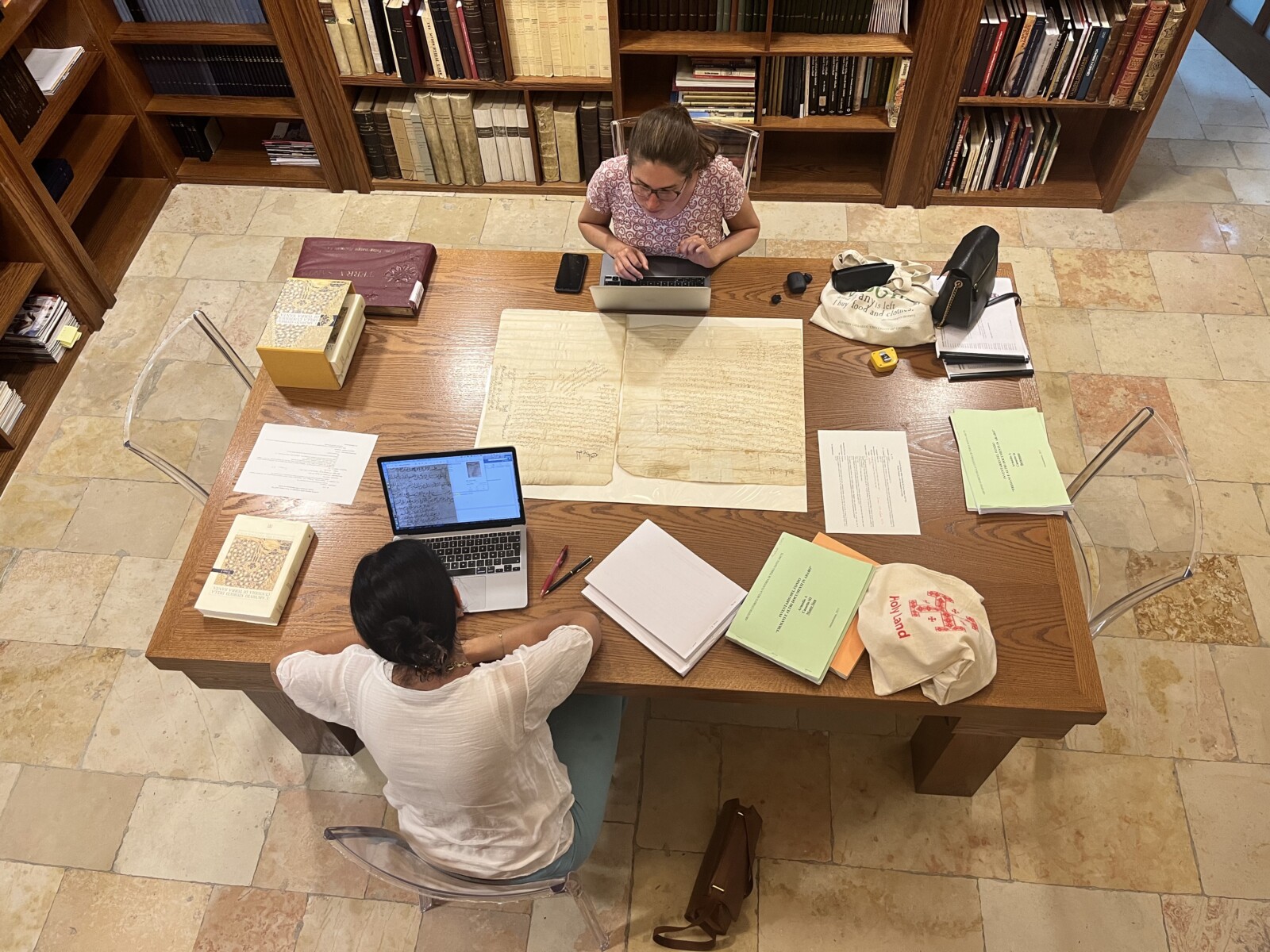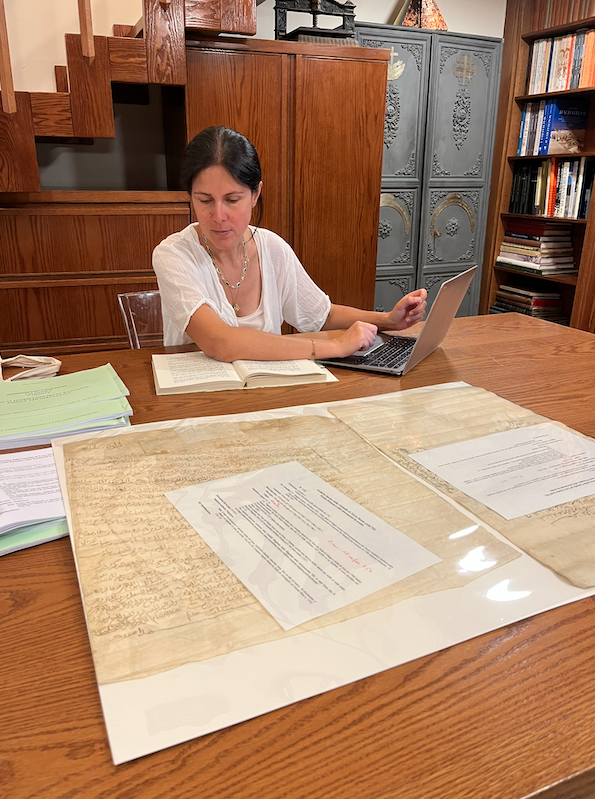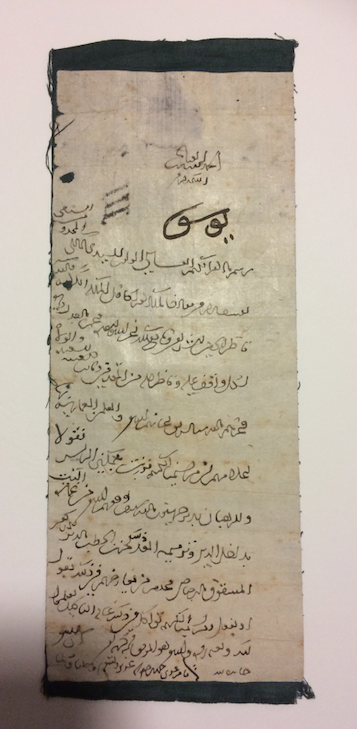When the Mamluk firmans break down the barriers of the churches in Jerusalem
In May 2022, Camille Rouxpetel and Alice Croq came to spend one month in Jerusalem, as part of a research project funded by the National Research Agency (ChrIs-cross) on the history of Jerusalem as it is preserved in the archives of the Churches in the Holy City. Our meeting.
Can you tell us about your respective backgrounds in a few words ?
Camille Rouxpetel : Alice and I both hold doctorates. Alice is a specialist in Arabic and Syriac manuscripts, she has worked a great deal on the Miaphysite Churches[1], and in Egypt, in particular on the colophons, those paragraphs that the scribes laced at the beginning or the end of the manuscripts. As far as I am concerned, I did my thesis on the representations of the Christians of the Orient in the Western sources in Armenia, Syria, Palestine and Egypt. I worked I particular on the accounts by pilgrims and missionaries from the 12th to the 15th centuries.
Ho did this research project come into being?
From 2015, I started to be interested in the archives of the Custody of the Holy Land. For the medieval period, it practically only has Islamic archives. Spending time on the spot and in particular in the archives of the other communities, I had access to the Mamluk documents [2] which are called hogget-s and firmans. These documents allow us to write the history of the dhimma [3] from the point of view of the Christians and have almost never been exploited. This way it becomes possible to write another history of the Franciscans, starting from the Near Eastern sources and considering the friars as players in their own right in Near Eastern society and not as expatriate Westerners.

Are any firmans to be found in Islamic institutions ?
The firmans are Islamic sources which came directly from the sultan while the hogget-s were issued by the courts of justice. For the Islamic period – and in particular for the Ayyubid and Mamluk periods – very few archives remain. Many of these archives have been preserved by and in the Christian institutions which have carefully kept them to assert their rights and their privileges. There are also deeds of property: they allow us to understand how the communities in Jerusalem were distributed.

Your research cross-references the collections of the different Churches in Jerusalem. How were you able to weave this trust with these different institutions ?
I have been coming regularly for seven years now. I have organized several days of study with the participation of members of the different churches. Bonds have been woven and, gradually, doors have opened, but this supposes spending time with the community and working with people on the spot. The Churches are aware of the importance of their archives and are already working on their preservation. But they have to keep working together so that they give more consideration to the importance of this specific collection which shows the diversity of the Muslim world. We have to remember that these medieval Muslim societies, even though relations of force or inequalities existed, were intrinsically plural societies.
Why are the Churches afraid to open their collections ?
The institutions are wary especially because the firmans touch on questions of property. As far as we are concerned, we are working on very ancient periods which do not question the present-day Statu quo. There is also a certain mistrust because the Churches at times do not know exactly what is in their archives. This needs time, but it is never time that is wasted. This is also what makes the this work beautiful and interesting, as it allows meeting many people. Spending time at the Custody I have changed my way of working, as well as my view on the Latins in Jerusalem. This has allowed me to consider them truly in the oriental word and not to westernize them.
How do these firmans show that the Custody is rooted in the Arab world?
The Franciscan firmans show us that the Custody really works as a Near Eastern institution, in the same way as the other Churches present in Jerusalem. We could believe that since the Franciscans depend on Rome, they are considered differently, but if we start from these Near Eastern sources, the Franciscans are dhimmi-s in the same way as the other Christians. We also have very early traces of Arab friars in the Custody.
What do these firmans allow saying about the nature of the relations between the Franciscans and the local authorities ?
The Churches are not passive and neither are the Franciscans! These documents illustrate how Islamic law is diffused and infused in the different layers of this society, including with these Latin Christians who have just arrived. The Custody was founded in the 14th century and, very quickly, the Franciscans were able to understand the rules of the game and in particular, the juridical rules. These firmans show that the Franciscans are going to take this right for their own and implement strategies to face the Islamic power. We have to understand that the medieval world is not fixed, it is different. We have to accept that we can have contradictory situations and that are concomitant at the same time. It is not ideal coexistence or total oppression! There are moments of tension, moments of agreement and the Christians succeed in keeping up in all that.

Can we see in this research an ecumenical project as it allows the Churches to get to know one another better ?
As a historian, the ecumenical question is not the purpose of this research. However, it is clear that the term “working with” includes coming into contact and communicating. The Latins have archives that concern the Greeks, the Armenians etc. and vice versa. This project could contribute to a common action by the Churches to show that Christianity in Jerusalem is an interlacing of Christianities. I think that it is important for contemporary stakes because those who write the history of these Churches are often either in an apologetic logic or in a logic of community and identity construction. Writing in this logic, the interest is not very much in the historical archives but more on the sources of doctrine or ecclesiastic history. The archives force us to work differently and in a less compartmentalized way. I would prefer the word “decompartmentalize” to that of “ecumenism.” Decompartmentalizing from a methodological point of view but also historical, to propose a more global and more connected history of these Christianities.
[1] The Churches known as Miaphysite refused the formulations of the Council of Chalcedon (451), which defined the unity of persona and the duality of natures in Christ. As a consequence, they separated from the Churches known as Chalcedonian, Rome and Constantinople, in 451.
[2] The Mamluk sultanate is the regime that governed the Holy Land from Cairo between 1250 and 1517.
[3] The dhimma or “pact of protection”, is the law under which the non-Muslims lived, placed under Muslim sovereignty.



